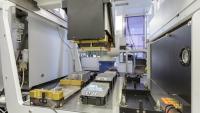RABiT
Rapid Automated Biodosimetry Technology

The overall philosophy behind the RABiT is to use full automation to speed up and improve the precision and accuracy of established biodosimetric assays. Full end-to-end automation of the assay and analysis has proved to be a successful approach for biodosimetry. This RABiT (Rapid Automated Biodosimetry Tool) approach has increased the potential throughput for conventional cytogenetic assays from less than 100/day to over 10,000/day, significantly higher than is possible from an individual, manually-based laboratory, or even a network of such laboratories.
Our original work focused on a custom robotic system, designed to analyze up to 30,000 samples per day for biodosimetry. The basic system involves two well-characterized assays with all the processing being carried out in-situ in multi-well plates.
Garty G, Chen Y, Turner HC. Zhang J, Lyulko O, Bertucci A, Xu Y, Wang H, Simaan N, Randers-Pehrson G, Yao YL, Brenner DJ. The RABIT: A Rapid Automated BIodosimetry Tool For Radiological Triage. II. Technological Developments. International Journal of Radiation Biology, 87:776-790 (2011). [PMC] [Journal]
With the rising prevalence of High Content Cellular Screening systems, a logical development is to adapt our RABiT protocols for direct use on these commercial high-throughput robotic machines - the "RABiT2" approach. In addition, to further increase speed, throughput, and reliability, our goal is to optimize the cellular assays in terms of accelerated assay time, simplified protocols, simplified image analysis and a shorter "time-to-answer" - all consistent with the RABiT2 approach.
Repin M, Turner HC, Garty G and Brenner DJ. Next generation platforms for high-throughput biodosimetry. Radiation Protection Dosimetry, 159:105-110 (2014). [Journal]
Analysis Program
The RABiT uses custom developed software for scoring γ-H2AX fluorescence and micronucleus yields. There has been a large demand to perform these analyses also on samples generated in other projects at the Center for Radiological Research. We have therefore bundled the Image analysis software with a convenient graphical user interface and Microsoft Excel-based reporting and made it available on several computers at the Center for Radiological Research. Two versions of the software have been developed for scoring micronuclei and for scoring immunostaining-based images (γ-H2AX and similar assays). Similar software development is ongoing for the dicentric and mBAND assays.